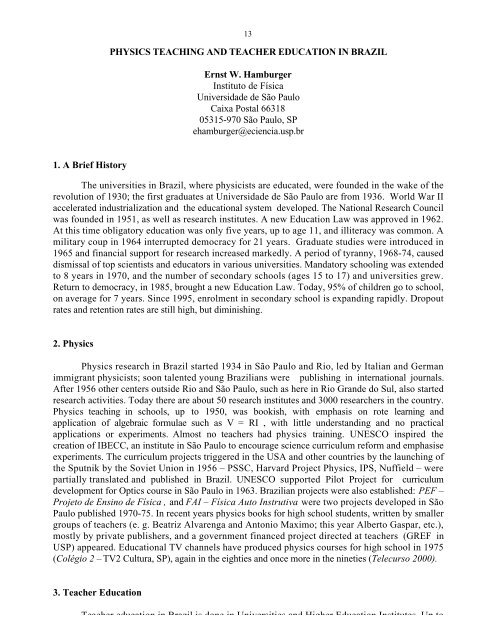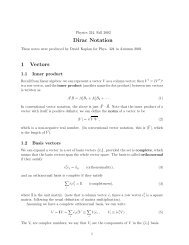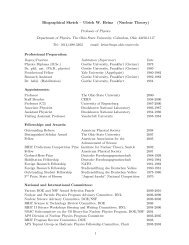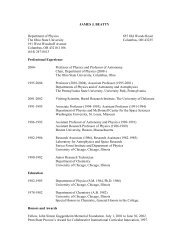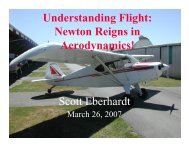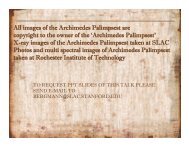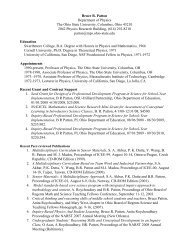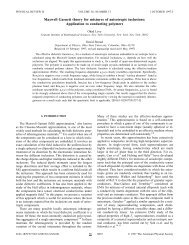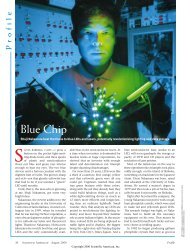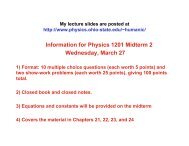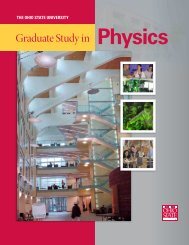Brasil Final Report - Department of Physics - The Ohio State University
Brasil Final Report - Department of Physics - The Ohio State University
Brasil Final Report - Department of Physics - The Ohio State University
You also want an ePaper? Increase the reach of your titles
YUMPU automatically turns print PDFs into web optimized ePapers that Google loves.
1. A Brief History<br />
13<br />
PHYSICS TEACHING AND TEACHER EDUCATION IN BRAZIL<br />
Ernst W. Hamburger<br />
Instituto de Física<br />
Universidade de São Paulo<br />
Caixa Postal 66318<br />
05315-970 São Paulo, SP<br />
ehamburger@eciencia.usp.br<br />
<strong>The</strong> universities in Brazil, where physicists are educated, were founded in the wake <strong>of</strong> the<br />
revolution <strong>of</strong> 1930; the first graduates at Universidade de São Paulo are from 1936. World War II<br />
accelerated industrialization and the educational system developed. <strong>The</strong> National Research Council<br />
was founded in 1951, as well as research institutes. A new Education Law was approved in 1962.<br />
At this time obligatory education was only five years, up to age 11, and illiteracy was common. A<br />
military coup in 1964 interrupted democracy for 21 years. Graduate studies were introduced in<br />
1965 and financial support for research increased markedly. A period <strong>of</strong> tyranny, 1968-74, caused<br />
dismissal <strong>of</strong> top scientists and educators in various universities. Mandatory schooling was extended<br />
to 8 years in 1970, and the number <strong>of</strong> secondary schools (ages 15 to 17) and universities grew.<br />
Return to democracy, in 1985, brought a new Education Law. Today, 95% <strong>of</strong> children go to school,<br />
on average for 7 years. Since 1995, enrolment in secondary school is expanding rapidly. Dropout<br />
rates and retention rates are still high, but diminishing.<br />
2. <strong>Physics</strong><br />
<strong>Physics</strong> research in Brazil started 1934 in São Paulo and Rio, led by Italian and German<br />
immigrant physicists; soon talented young Brazilians were publishing in international journals.<br />
After 1956 other centers outside Rio and São Paulo, such as here in Rio Grande do Sul, also started<br />
research activities. Today there are about 50 research institutes and 3000 researchers in the country.<br />
<strong>Physics</strong> teaching in schools, up to 1950, was bookish, with emphasis on rote learning and<br />
application <strong>of</strong> algebraic formulae such as V = RI , with little understanding and no practical<br />
applications or experiments. Almost no teachers had physics training. UNESCO inspired the<br />
creation <strong>of</strong> IBECC, an institute in São Paulo to encourage science curriculum reform and emphasise<br />
experiments. <strong>The</strong> curriculum projects triggered in the USA and other countries by the launching <strong>of</strong><br />
the Sputnik by the Soviet Union in 1956 – PSSC, Harvard Project <strong>Physics</strong>, IPS, Nuffield – were<br />
partially translated and published in Brazil. UNESCO supported Pilot Project for curriculum<br />
development for Optics course in São Paulo in 1963. Brazilian projects were also established: PEF –<br />
Projeto de Ensino de Física , and FAI – Física Auto Instrutiva were two projects developed in São<br />
Paulo published 1970-75. In recent years physics books for high school students, written by smaller<br />
groups <strong>of</strong> teachers (e. g. Beatriz Alvarenga and Antonio Maximo; this year Alberto Gaspar, etc.),<br />
mostly by private publishers, and a government financed project directed at teachers (GREF in<br />
USP) appeared. Educational TV channels have produced physics courses for high school in 1975<br />
(Colégio 2 – TV2 Cultura, SP), again in the eighties and once more in the nineties (Telecurso 2000).<br />
3. Teacher Education<br />
Teacher education in Brazil is done in Universities and Higher Education Institutes. Up to


